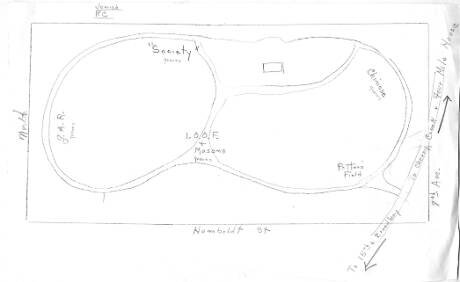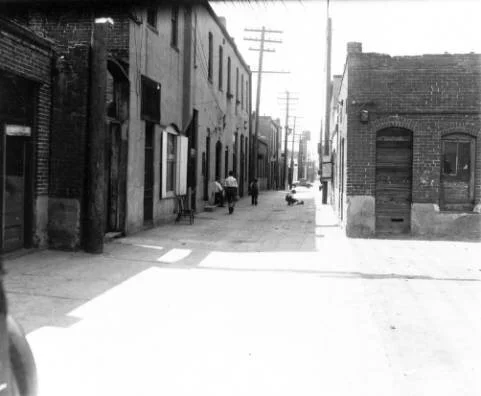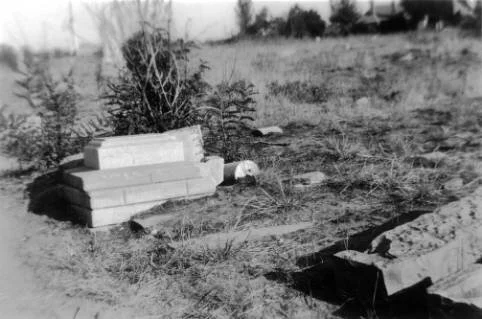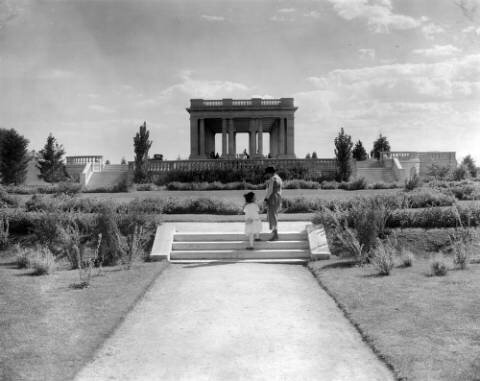Situated southeast of downtown Denver sits a large park that on any given summer day is full of people basking in the sun, jogging, or playing with their dogs. It seems like just a normal park until you learn that the 80 acres it covers were once Denver’s pioneer cemetery. It is also very close to the site of the house that inspired the book (and movie) The Changeling. The story of what happened to turn this cemetery into a park is more macabre than you might imagine.
Around 1859, General William Larimer set aside 320 acres of land for a cemetery. 1Colorado Encyclopedia, and Mount Prospect Cemetery was born. As early as 1863 a large portion of the cemetery was in serious disrepair. Cattle were allowed to roam freely through the cemetery, and the city didn’t put any effort into caring or maintaining for the graves.2Rocky Mountain News Weekly, January 8, 1863 Around 1872 it was determined that the cemetery was actually on federal land and Congress sold it to the city of Denver under the condition that it always remained a cemetery.

Around 1875 twenty acres were sold to the Hebrew Burial Society for Jewish burials. The rest of the cemetery was parceled out into sections for the different ethnic groups and fraternal organizations. At the south end of the cemetery slightly separated from the rest was a section for the Chinese.
Jack O’Neils Ranch
Just a few short years later Denver citizens were referring to the cemetery as the Old Boneyard, Boot Hill, and Jack O’Neils Ranch. A few other cemeteries had popped up around Denver and soon Mt Prospect was left to bury the “undesirables” such as the poor, the unwanted, and outlaws.

Image – Western History and Genealogy Dept., Denver Public Library
Jack O’Neil was a very popular, reportedly a very handsome man of “powerful physique.” He was gunned down in a Denver saloon on March 30, 1860. Following his death citizens debated on where he should be buried. The Mt. Prospect Burial Association offered to bury him at Mt. Prospect for free, which ruffled the feathers of the Denver elite. His burial started a precedent that led to the outer portions of the cemetery becoming the place to bury criminals.
Once the cemetery had gotten the nickname of Jack O’Neils Ranch the influential citizens of Denver decided they could not be buried amongst such riffraff and Mt Prospect cemetery was left to be a Potter’s field.
The Death of The Cemetery
By the late 1880s, the cemetery was an absolute mess. Some of the graves were still tended by families and were in good shape, but most of the graves were uncared for and the cemetery was covered with weeds and junk. In 1901 it was remembered as being a “treeless, shrubless, waterless, utterly forsaken and neglected except by the prairie dogs.”3 Cheesman Park Hill History The neighborhood that was now surrounding the cemetery had become one of the most exclusive parts of Denver and the influential families complained about the unsightly Mount Prospect Cemetery.
Before long real estate developers began lobbying for Mount Prospect Cemetery to be turned into a park. Because it was later determined that the cemetery was located on Federally owned land, Colorado State Senator Henry Moore Teller persuaded Congress to allow the cemetery to be converted into a park and on January 25, 1890, Congress voted to allow the city to vacate the cemetery. In recognition, the park was named Congress Park. Because of the large number of Catholic graves in the eastern portion of the cemetery, Denver Mayor Joseph Bates sold the 40-acre section to the Archdiocese of Denver and it was renamed Mount Calvary Cemetery.

Image Courtesy –Western History and Genealogy Dept., Denver Public Library
The Chinese section of the cemetery was given to the Chinese community who lived in the “Hop Alley” district of Denver. Due to Chinese customs, most of the bodies in this section were removed and shipped back to China for burial.
The Graveyard Conspiracy
After it was determined that the cemetery was to be vacated, the Mayor of Denver made an announcement for families to arrange for the removal and reinternment of their loved ones. After approximately a year, the city realized that there were still many bodies left in the cemetery and opened up the task of removal and reburial for bids. A local undertaker named E.P. McGovern won the bid and would be paid $1.90 (approx $53 today) for each box moved and reburied in Riverside Cemetery. On March 24, 1893, the Denver Republican published a letter from Mayor Platt Rogers to E.P. McGovern effectively charging him with fraud and removing him from his duties.
The Mayor pointed out the following issues in his letter to McGovern:
- Boxes were not made of surface lumber and not the correct size
- Joints were not made perfectly tight with white lead
- The City Inspector reported that a solution of corrosive sublimate was not used in the manner and amount required
- Quick lime was not used in the manner and amount required
- No evidence that a house for the workingmen to wash and change their clothes was provided
- No evidence that the workingmen were compelled to wash and change their clothes prior to leaving the cemetery

And the most damning accusal of all was that the city inspector found evidence that bodies from certain graves were divided and placed in two or more boxes, and in other cases, boxes that were sent to Riverside Cemetery contained nothing at all, or simply fragments of wood. The city inspector went to Riverside Cemetery and dug up a box marked B.H. 274 and found that it contained 2-3 small pieces of wood which they assumed were the remains of a coffin.4 Denver Rocky Mountain NewsFriday, Mar 24, 1893, Denver, CO Page: 3
When McGovern’s contract was canceled the city knew that hundreds of graves had not been reached, and yet a new contract for the removal of the bodies was never awarded. It seems the city had had enough.

Image Courtesy –Western History and Genealogy Dept., Denver Public Library
A Morbid Park Is Born
By 1894 a fence was erected around the new park, leveling of the ground was begun, and grass was planted over land that still contained hundreds of bodies. The Hebrew section of the cemetery remained until 1910 when it was sold back to the city and the bodies moved, and the Catholic section of the cemetery remained a cemetery until 1950 when the land was sold back to the city and approximately 6,000 bodies were moved to another location.
In 1907, a successful Denver businessman named Walter Cheesman died and his wife told the city that she would donate a marble pavilion to the park if the name were changed to Cheesman Park. And so, Cheesman Park was born.

Image Courtesy –Western History and Genealogy Dept., Denver Public Library
Strange Sightings
It shouldn’t come as a surprise that people have experienced unexplainable things at Cheeseman Park when there are an estimated 3,000 bodies lying underneath the ground.
It’s a beautiful green area and when I was there there were numerous people lying on the grass and jogging around the park perimeter with their dogs.
However, many people who visit the park say they feel overwhelmed with a sense of sadness and even dread.
Rumors of paranormal activity began to haunt this location as soon as the bodies were being removed. Locals that lived near the now park reported ghostly activity in their homes and complained that the souls were unhappy and were wandering about.
Children have been seen playing in the park late into the night who then simply vanish into thin air.
One woman observed a woman who was singing in the park, her clothing was out of place and dated and the observer thought this was really strange. As she stopped to watch the singing woman, the lady simply vanished. Some people even say on moonlit nights if the conditions are just right you’ll even see the ghostly forms of long gone headstones.








2 comments
[…] Shadows From Beyond the Grave: The Ghost Lore of Cheesman Park Published: October 18, 2019 […]
[…] making stops along the way to its final destination in San Francisco. By the time it reached Denver, nothing was out of the ordinary. The flight crew changed, the passengers stretched their legs, and […]